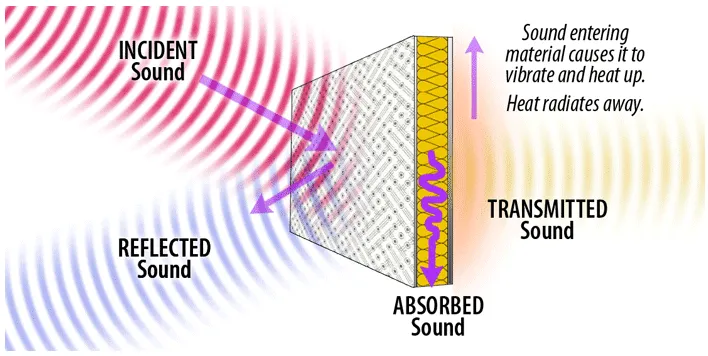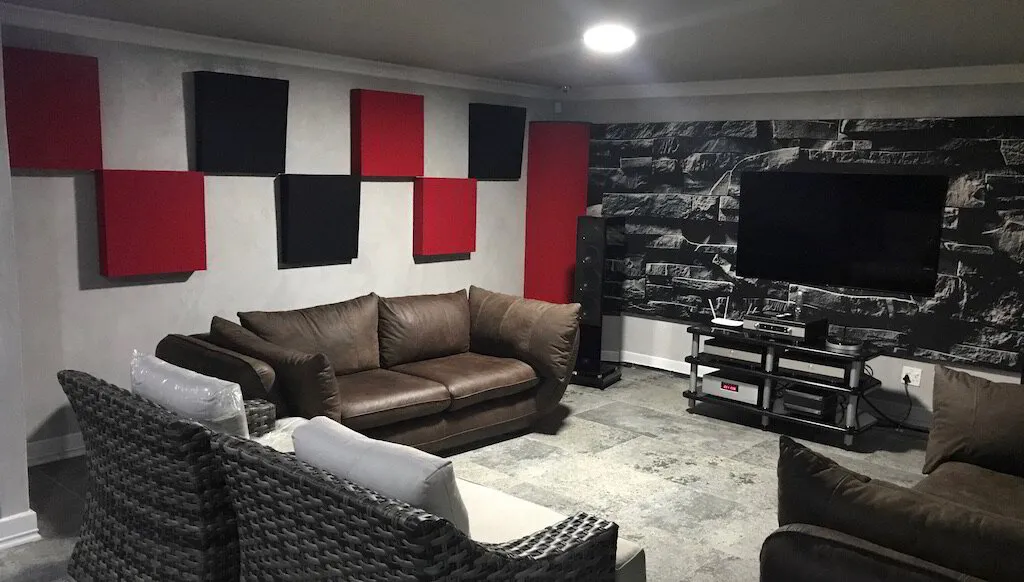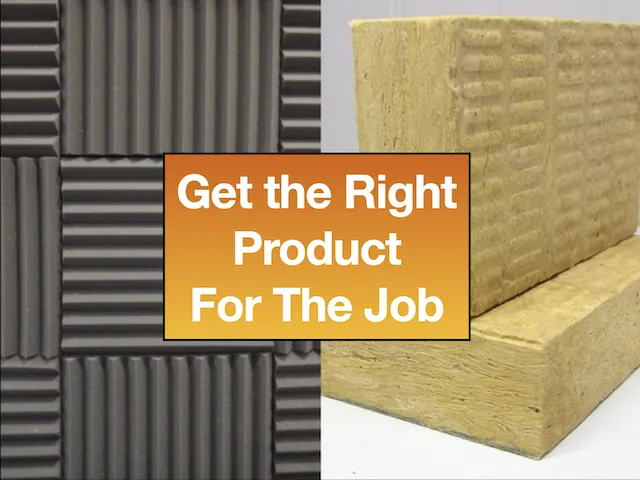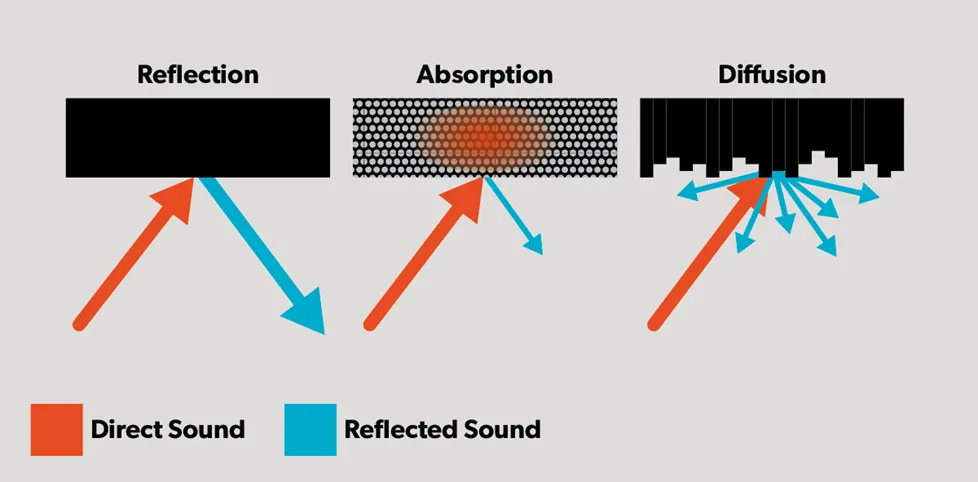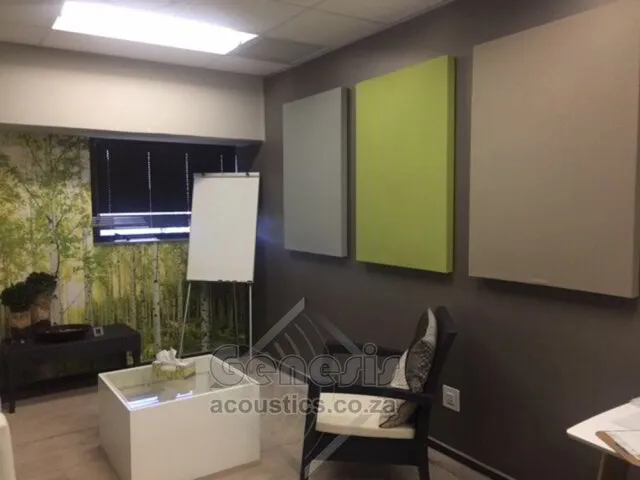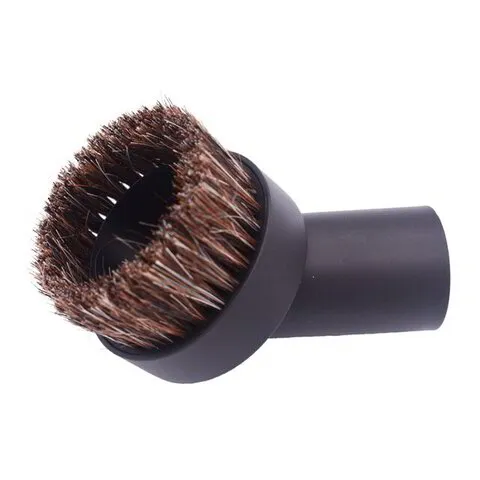Fabric Wall Acoustic Decor: The Ultimate How-To Guide
Article written by Brett Robinson the owner of Genesis Acoustics, 4th September 2023
Fact checked by Steven Kartapanis, who studied acoustics at the Berklee College of Music
Are you looking to transform your space into something truly remarkable? If so, then a Fabric Wall might be just what you need. Upholstered walls and panels can add a touch of elegance and sophistication to any room, while also providing numerous practical benefits such as enhancing the sound in the room by reducing echo and soundproofing between rooms - both of which lead to more productive spaces.
In this blog, we will explore the world of fabric walls and how they can completely change the look and feel of your space. We'll look at the opportunities and benefits of installing fabric wall in a variety of venues from homes to corporate office spaces, hotels, restaurants, schools, churches, radio stations and recording studios.
This blog will provide all the information you need to make an informed decision.
What is Fabric Wall?
View the process from start to finish in the below images.
There are three components to the Fabric Wall system - as supplied by Genesis Acoustics.
1. Fabric Tensioning Profiles
We supply a range of 26mm thick, plastic tensioning profiles. We own the moulds and manufacture the various profiles right here in Johannesburg, South Africa. This gives us complete control of the design and manufacture process, ensures the availability of stock and avoids the high costs of international shipping, clearing and duties, incurred by buying in product from a factory overseas.
Our plastic profiles have several advantages over the aluminium variety:
- They are cheaper
- Quicker and far less noisy to cut
- Safer - no aluminium filings, no sharp edges
- Easier to install
- Easier to clean up after an installation
- It's easier to replace the original fabric, should you choose so at a later point in time.
2. Acoustic / Thermal Infill
We use a medium - high density acoustic / thermal insulation in-between the framing. This serves to absorb sound and provide valuable thermal insulation in the room but I'll go into more detail later in the article. This product serves to provide the sound absorption and thermal insulation to the Fabric Wall system.
3. Finishing Fabric
Although it's possible to use almost any fabric, it stays to reason that some fabrics are better suited than others. A commercial grade upholstery fabric is a good start as it's strong, durable and thick enough to grip well in our tensioning profiles. The fabric must be acoustically transparent to sound to ensure that sound is efficiently absorbed by the acoustic insulation, instead of the being reflected back into the room.
Customer Testimonial
"In a busy environments such as our restaurant, Genesis acoustics was able to advise and professionally install an acoustic panel solution that not only made a major improvement to the experience for our guests and staff, but the sound panels also look gorgeous!
Thanks so much to Genesis, we can confidently recommend Genesis to any business looking to improve the acoustic sensory experience of its patrons and staff."
Christo Miliotis
Installation Process & Tips
If you want to install yourself or will get a contractor to install - then here is the 7 step installation process:
- Design & specification: Plan the design & layout. Consider factors such as the textures, colours, prints, overall size, thickness & acoustic specification required, in order to achieve your goals.
- Procurement: Order the necessary framing, infill, adhesive, fabric & sundries. Prepare your tools list.
- Map the design on the wall/s: Measure carefully then mark out the wall according to the design. Use a spirit level or laser level to make sure all lines are plumb and make pencil marks to guide the next step.
- Prep & fixing: Ensure that you have correct fabric tensioning profiles (there are 4 profiles) and an adequate quantity of each type to finish the job. Drill pilot holes through the tensioners at 30cm intervals. Now fix the fabric tensioning profiles to the wall, according to the design layout. The type of fixing screw you use will depend on the the type of wall you are fixing the framing to. For drywalls use a 16-25mm drywall screw. For masonry walls use a 40mm length screw & plug.
- The Acoustic Infill: Fix the acoustic insulation in-between the framing with the necessary adhesive.
- Tucking the fabric: Tuck the fabric into the framing. Start with intermittent tacks across the top edge to position it in place then start tucking around the perimeter until it is positioned to your satisfaction. Now begin to tension the fabric by working opposite sides. Continue with the tucking process until the fabric is flat, smooth and fully tensioned. Finally cut off extra unwanted fabric, tuck in any loose ends and trim off any exposed threads.
- Finishing: Clean up and address any minor snags.
If all this seems like a lot of work, then consult with Genesis Acoustics and we will make it easy for you. We can take care of everything from the consultation, to the design, costing, planning and installation. Our trained staff have extensive experience all of which helps to ensure a quick and pleasing result on site.
Contact us
Need help with your project? We're here to chat and get things moving in the right direction.
Fabric Wall Acoustic Decor vs Wallpaper
Fabric Wall and wallpaper both have decorative value, however there are many differences.
5 Key Differences:
- Wallpaper is only used for decoration whereas Fabric Wall also has amazing sound absorbing and thermal insulation properties.
- Wallpaper is very thin however Fabric Wall is at least 26mm thick.
- Wallpaper is stuck directly to the wall and is therefore hard like the wall however Fabric Wall is soft, compressible and luxurious to the touch.
- Wallpaper cannot be refurbished, you either have to rip it off or stick a new wallpaper over it. Fabric Wall can easily be refurbished, simply pull out the old fabric and tuck the new fabric into the same tensioners.
- Wallpaper cannot be repaired, if a section is damaged then you might have to redo the entire wall. Fabric wall can easily be repaired. Simply replace the one damaged section with new fabric.
Contact us
Need help with your project? We're here to chat and get things moving in the right direction.
Customer Testimonial
"Needed something for noice and echo. We got exactly what we wanted. The sound is amazing!
Super-friendly staff that cared about what we wanted and provided all the information on the product to help make the right decision.
Great experience with Genesis Acoustics Soundproofing! Highly recommend them."
Hema Daya
Thermally Insulate Cold Exterior Walls
Depending on your climate, exterior walls can often be cold in the winter months therefore increase heating costs. Installing a fabric wall, inside your room, on an exterior wall, will thermally insulating the wall, this helps regulate the room's temperature. Fabric Wall will be warmer to the touch and provide the comfort of thermal insulation to those inside the room. Therefore an insulated Fabric Wall will contribute to energy efficiency and lower utility bills.
Insulating an Exterior Wall is Beneficial when:
- Bedrooms: The bed is positioned right up against or near to an exterior wall.
- Study or offices: If a desk is positioned next to an exterior wall.
- Living room: Your couch is positioned by an exterior wall
- You prefer a comfortable, well insulated, and peaceful space.
Contact us
Need help with your project? We're here to chat and get things moving in the right direction.
3 Acoustic Benefits of Upholstered Walls
Insulated fabric wall coverings not only enhance the aesthetic appeal in a room but they also offer practical benefits in sound management. The Fabric Wall system can help with sound absorption and sound insulation, making it an excellent choice for rooms with hard surfaces such as wooden , ceramic or concrete floors, glass, drywalls, plastered brick walls etc all of which are highly reflective to sound.
A Fabric Wall in your room, office or venue offers two key psychological benefits that have a real effect of our mental clarity. How is this possible? By reducing unwanted background noise, they help to create a peaceful and quiet environment. They also enhance privacy in offices & meeting rooms, conference rooms benefit from better speech intelligibility and in shared spaces the overall level of the ambient sound is reduced. The bottom line is excessive echo, reverberation and background noise is detrimental to our ability to focus and be productive.
1. Improved Level of Productivity
That's a big claim, so how is it justified? Well it's simple, high levels of ambient noise are a distraction, because our brain is constantly working to filter out the background noise, it causes mental fatigue, which makes it difficult to focus and think clearly.
High noise levels and distracting sounds also hinder clear communication because they cause a loss in speech intelligibility. Sound absorbing wall panels reduce the disturbance of loud ambient noise levels, making it easier to focus and as a result cognitive performance is enhanced. Fabric Walls create a peaceful space, promote clear and articulate communication and therefore an environment that promotes productivity.
2. Stress Reduction
Exposure to constant noise can increase stress hormone levels, leading to mental fatigue. Soundproof building structures and sound absorbing wall panels offer a solution by reducing noise from outside sources like traffic, thunder storms, airplanes flying overhead, wind noise, lawn mowers and weed eaters or even loud neighbours etc. Sound control products can create a quieter space that promotes relaxation and improves overall well-being. Numerous studies have shown the positive impact of reducing stress.
3. Enhanced Rest & Better Sleep
Fabric walls are not only beneficial in public spaces such as churches and work environments, but they can also enhance the quality of sleep. Noise can disrupt our restorative sleep cycles, leading to a lack of energy and productivity during the day. However, with the installation of sound absorbing wall panels, unwanted noise from outside sources such as traffic, loud neighbours, dogs barking etc can be greatly diminished. By creating a peaceful and quiet sleeping environment, fabric walls contribute to a better night's sleep and overall well-being.
Contact us
Need help with your project? We're here to chat and get things moving in the right direction.
The Difference Between Soundproofing & Sound Absorption
Soundproofing and sound absorption are very different, it's important to understand what these differences are so that you can plan correctly and achieve the best possible outcome.
Sound Absorption
This is also referred to as acoustic treatment or sound dampening. Sound absorption solves the problems associated with rooms that are characterised by large volumes and hard surfaces both of which result in long reverberations times / echo.
Reverberation time in a venue is judged by a standard called the RT60, which is the amount of time it takes for sound to decay from its peak amplitude, by 60 decibels.
Uncontrolled sound waves and long reverberation times are detrimental to the clarity and quality of sound in the venue. Other factors which contribute to long reverberation times are high ceilings or even with no ceiling and open to the concrete slab or roof, hard floors, spans of glass, plastered walls or drywall and hard floors. The greater the surface area with finishes that are hard and reflective to sound - the greater the echo and degradation of sound quality.
An abundance of hard finishes also tend to create higher levels of ambient sound, this means that the more people in the venue the louder it gets and the more difficult it becomes to be clearly heard and understood. This is referred to as speech intelligibility and is naturally vitally important for the proper function of any venue, where music or conversation takes place.
Sound absorbing products are used to absorb the sound energy that would otherwise have been reflected off hard surfaces back into the room. The more sound absorption, the less resonance and the less background noise generated in the room by sources such as sound systems, people moving around, conversation etc.. The lower the levels of background noise the higher the level of speech intelligibility.
The acoustic performance of a sound absorbing product can be measured as a percentage and is referred to as the sound absorption co-efficient. For example, a product that offers 80% sound sound absorption at 500Hz is expressed as 0.8.
The effect of sound absorption in a room will be determined predominantly by two factors:
- The sound absorption co-efficient of the various materials used inside the room e.g. flooring, ceiling, walls, furniture & other furnishing such as curtaining.
- The percentage coverage in m² relative to the size and volume of the venue.
Soundproofing
Soundproofing refers to the construction methods & materials, used to attenuate or mitigate the transfer of sound between adjacent rooms or spaces. A room can be properly soundproofed but still be highly resonant and suffer from poor acoustics. Conversely a room can have a lot of soft sound absorbing materials which result in a very short reverberation time, however if there is insufficient mass in the structure of the room or it has any gaps through which sound can travel then it will still suffer from poor sound isolation.
Contact us
Need help with your project? We're here to chat and get things moving in the right direction.
Selecting the Right Thickness for Your Space
Fabric Wall starts from 26mm thick and can scale up to just about any thickness. We typically offer our clients one of three thicknesses as these satisfy most requirements, however the thickness can be customised.
Why adjust the thickness of the Fabric Wall?
The answer lies in the fact that as mentioned previously, both the level of sound absorption and sound insulation is scalable. As the acoustic insulation increases in thickness, so does the level of sound absorption.
A 25mm thick acoustic insulation can be highly efficient in the high frequency range but does not perform as well in the mid range and has a very nominal performance in low frequency range. As the thickness of the acoustic insulation increases, so does the level of sound absorption in the mid to low frequency range.
Sound absorption is frequently rated with a Noise Reduction Coefficient (NRC) and while this is useful, it's important to remember that it does not take into consideration the level of sound absorption below 250Hz. This must be taken into careful consideration, depending on the type of venue.
The Best Thickness For Different Types of Rooms
The increased cost of a thicker fabric wall means it needs to be justifiable to the benefits achieved. The types of venues that will benefit sufficiently for the extra cost to be well worth the expense are venues that either need far superior soundproofing, sound absorption or both. Many times these are venues that have live musicians, use high end or big sound systems or produce significant noise levels.
The below is not a comprehensive list and is simply a guide.
26mm Thick
Meeting rooms such as: Boardrooms, offices, video conferencing rooms, lecture theatres, training rooms, classrooms, podcast rooms, radio stations etc.
50mm Thick
Rooms with a sound system. Best used on the side walls of venues such as churches, live music venues, theatres, school halls etc.
100mm Thick
The only time to use a 100mm thickness is when you need excellent absorption in the low frequency range. At this thickness the Fabric wall essentially starts becoming a bass trap. This does not mean it stops all the bass - quite the contrary. It will clean up the sound in the low frequencies , giving a clear and articulate low end and preventing a muddy sound.
Types of venues which will benefit: Recording studios, commercial cinemas, home cinemas, TV Rooms, games rooms, Hi-Fi listening rooms, the back and stage wall in live music venues, churches with full bands, industrial testing facilities etc.
The Thickness Directly Effects The Level of Sound Absorption
Note that these are just examples and the exact % sound absorption can vary depending on the type of insulation actually used.
- 25mm Thick = NRC 0.85
- 50mm Thick - NRC 0.9 - 1.0
- 100mm Thick - NRC 1.0
From the above data one might conclude that the difference between the level of sound absorption between the various thicknesses is only nominal but nothing could be further from the truth. In actual fact, the sound absorption from 25 - 100mm thick more than doubles.
Acoustic treatment is not a one size fits all type solution, the level of sound absorption should be designed and specified to suite to the needs and function of the room or venue.
Padded Walls
Another reason to increase the thickness is to achieve the desired look. For example perhaps you want the edges of each panel to have a rounded look to create a luxurious appearance. This could be ideal for example in a bedroom on the wall behind the bed.
Padded walls have been used extensively in medical facilities, in rooms for patients under going psychiatric care.
Contact us
Need help with your project? We're here to chat and get things moving in the right direction.
The Different Types of Acoustic Padding
There are a couple of products which can be used in between the fabric tensioners. Which option you decide on will be based upon the cost per m², acoustic performance, thermal properties, availability, ease of installation and the type of installation.
Acoustic Foam
While acoustic foam works very well it's generally the most expensive option. The additional cost of the acoustic foam is justifiable when it's used as the final finish but doesn't make as much sense when it's covered by a fabric.
Most acoustic foam is offered in the form of a profiled tile, although sometimes it is also available in panels or sheets. The profiled finish is a large part of what makes acoustic foam an attractive option.
One big advantage of using foam is that it has an excellent memory, this is to say that if it is compressed it immediately bounces back to its original shape. This could be an advantage in certain situations e.g. if Fabric Wall was installed behind a bed as a headboard then foam would definitely be the preferable option as it would be the most comfortable to lean up against when sitting in bed and would retain its shape.
Foam is however the easiest product to work with during installation. Foam is a cellular product, thus when cutting it to size there are no loose fibres, this means less clean up.
Foam is also soft on the hands and does not irritate the skin.
Glass Wool, Mineral Wool or Rockwool
These products have 4 benefits over acoustic foam:
- Cheaper per m²
- Non-combustible. Foam is typically either flammable or flame retardant.
- They also typically offer sound absorption which is equal to or better than an acoustic foam.
- Higher density equals better sound insulation
These products are sold in various densities, the lower the density the lower the price, the higher the density the higher the price. Having installed thousands of m² over many years we prefer to use a density between 48 - 60kg/m3 as it offers excellent acoustic performance and does not compress easily, slump or collapse like a lower density tends to do.
These products are available in rolls and batts but we prefer to work with the batts, the joins between the batts are not seen as they are covered by the fabric finish.
Contact us
Need help with your project? We're here to chat and get things moving in the right direction.
Fabric Wall & Soundproofing
Can Fabric Wall be used for Soundproofing? The short answer is yes - maybe. Let me explain.
Remember that soundproofing is scaleable, you can have a little or a lot and anywhere in-between. The trick is to get the right amount of soundproofing to meet your needs.
If you try to cut corners you'll likely be disappointed but go overboard and you could spend more than you need to. There is big difference in the degree of soundproofing that's required for a meeting room and a recording studio and there's a direct correlation in the cost as well.
The key is to find the sweet spot between cost and acoustic performance.
What are Soundproof Wall Panels?
Although "soundproof wall panels" is a term that people use when searching online, I don't particularly like the term because:
- For the most part it is misleading.
- The correct use of soundproof panels is often not understood.
Let's first consider the merit or flaws of soundproof panels in the context of this article about using upholstered Fabric Walls inside buildings.
It stands to reason, that if a hollow drywall for example, divides two rooms and has very poor sound attenuation properties, then you cannot simply hang a few sound absorbing wall panels on the wall and expect the level of soundproofing to have improved. This is because the basic structure of the wall will not have changed.
However if the entire wall is treated with suitable acoustic materials, in line with proper acoustic principles then of course a better outcome can be expected. A Fabric Wall installation over drywall, can for example utilise a mass loaded vinyl backing, to increase mass and therefore improve the level of soundproofing.
Sound Proof Panels for Rooms - Real or a Fallacy?
When it comes to soundproofing walls, some key factors to consider are the thickness, density, type of materials used and method of the construction. Soundproofing closed architectural spaces will always involve carefully analysing and specifying each and every element of the building structure, in order to ensure that the acoustic objectives are met.
No panel inside a room, is going to block all the sound as this is simply not realistic. However here are some examples of panels that are used to block sound:
Open Office Spaces
Acoustic desk partitions can be used to enhance the level of privacy between desks, to reduce the overall noise level and to help reduce the amount of background noise that is heard when on the calls.
Recording Studios
In the context of sound, a "gobo panel" refers to a freestanding panel that is used to block or control sound. These panels are often used in recording studios, rehearsal spaces, and other environments where sound control is essential.
The term "gobo" is believed to be an abbreviation for "goes before optics" or "go between."
The Function of Gobo Panels is:
- Isolate Instruments: In a recording studio, gobo panels can be placed between instruments to prevent the sound of one instrument from bleeding into the microphone of another. This allows for clearer recordings of individual instruments.
- Control Room Acoustics: Gobo panels can be used to adjust the acoustics of a room by reducing reflections and controlling sound waves. This can help in achieving a desired sound quality during recordings.
- Create Temporary Sound Booths: Gobo panels can be arranged to create a makeshift vocal booth or isolation booth in a larger room.
- Reduce Ambient Noise: In rehearsal spaces or live performance settings, gobo panels can be used to block out external noises or reduce the sound leakage to neighboring areas.
Gobo panels are typically made of dense materials that are effective at blocking sound. They may also have absorptive surfaces to reduce sound reflections. The design and materials used can vary based on the specific sound control needs of the environment in which they are used.
Soundproof Panels Are Also Known as Noise Barrier Panels
Another legitimate use for soundproof panels is to block or attenuate machine noise, by positioning them around the sound source but without building a full enclosure.
Sometimes this type of solution is more desirable, so as not to restrict airflow or perhaps to ensure ease of access to a machine or petrol or diesel generator as an example. A better name for soundproof panels is "noise barrier panels". Genesis Acoustics offer a range of LF125 Noise Barrier Panels.
Contact us
Need help with your project? We're here to chat and get things moving in the right direction.
Fabric Walls Offer Endless Decorative Possibilities
With a wide variety of colours, designs, and textures available, you can customise the look of your space while enjoying the many acoustic benefits.
How to Select The Correct Type of Fabric
It is crucial to select a fabric that is acoustically transparent for optimal performance. It's easy to test a fabric to see if it's suitable, cover your mouth with the fabric, if you can breathe through it then at least from an acoustic point of view it's acceptable. If the fabric is not breathable then you need to rather select a different type of fabric.
There are various types of fabric options such as: Polyester, cotton, a blend of the two and microsuede.
Plain Colour Fabrics
Plain colour fabrics don't have to be boring, in fact they work well for the vast majority of installations. We offer 65 designer colours which include neutral colours, stoney / earthy colours and a range of bold colours - there's something there to suite almost any decorative environment.
Velvet Adds a Touch of Luxury
There's something luxurious about the look and feel of velvet. In the right setting, such as in a bedroom on the wall behind the bed, it can add a touch of class. Whether you would choose velvet in a bedroom, restaurant, hotel or meeting room is really dependant on your own style but it's great to have options.
Patterns
Patterns can add a unique and eye-catching element to your fabric wall. From geometric designs to floral motifs, there are endless possibilities to choose from. Whether you want to create a bold statement or add a subtle touch of elegance, patterns can help you achieve the desired aesthetic for your space.
Textured Fabrics
If you're looking to add depth and visual interest to your fabric wall, textured fabrics are the way to go. From ribbed textures to woven patterns, these fabrics can transform a plain wall into a work of art.
Prints
Printed acoustic panels offer a visually appealing solution for sound absorption. Prints offer complete creative freedom to fit your personal style or corporate branding requirements.
You don't have to choose between colour or prints, why not use both? We have done many jobs where a combination of plain colour and printed finishes are used together for a visually dramatic and pleasing effect.
Contact us
Need help with your project? We're here to chat and get things moving in the right direction.
Fabric Wall vs Upholstered Wall Panels
There are some big differences and a couple of similarities between the Fabric Wall system and upholstered wall panels (UWP). Both systems can utilise the same types of acoustic insulation but here's where the similarity ends.
Differences Between Fabric Wall & Wall Panels:
UWP's are pre-manufactured off site and hung to the wall on site, using a wall bracket.
Fabric Wall is fixed directly to the wall on site.
UWP's are limited in size due to transport and handling constraints.
Fabric Wall is unlimited in size, it can cover any size wall.
UWP's are hung as individual panels or in groups of panels e.g. a group of 3.
Fabric Wall has the flexibility of covering only a section of wall to an entire wall for a neat continuous look.
UWP's are limited in scope in large venues such as school halls, lecture theatres, cinema rooms, function venues, churches, broadcast studios etc.
Fabric Wall can easily be scaled up from small to large depending on what is best for the venue.
Which system is better for you really depends on the application, your budget and your preferences.
Have a chat with one of our acoustic consultants, to get a clearer picture of what will work best in your situation.
Contact us
Need help with your project? We're here to chat and get things moving in the right direction.
8. Maintenance & Cleaning
When it comes to maintenance and cleaning, both the Fabric Wall system and upholstered wall panels have their own considerations.
For UWP's, since they are pre-manufactured off-site and hung on-site using a wall bracket, they can be easily removed for cleaning or maintenance purposes. This makes it convenient to address any stains or marks that may appear over time.
As Fabric Wall is fixed directly to the wall on-site, they are cleaned in position.
Cleaning Frequency
Over many years of installations, we have found that our fabric wall panels are low maintenance and generally do not require frequent cleaning. Once a month or even every alternate month you could clean the dust away. If the top edge of the panels is exposed then this is where dust collects. If the Fabric Wall extends to ceiling height then there isn't really anywhere for dust to settle.
How to Clean
- Avoid: Preferably avoid wet cleaning. Avoid spraying the fabric directly with detergent or wiping them with a cloth saturated in water or detergent. If you spray water or detergent directly onto the fabric, when it dries you may end up with a mark where it dried.
- Dust wand: Use a soft dust wand designed to attract and hold dust.
- Soft bristle brush attachment: Some vacuum cleaners come with a soft bristle brush which is attached directly to the hose - this can prove useful for any exposed top edges that may collect dust.
- Damp cloth: Alternatively wet a clean cloth, squeeze out all the water and then wipe down the top edge. It shouldn't be necessary to wipe down the whole vertical surface area.
Repair or Replace
In the unlikely event that the fabric is damaged and cannot be cleaned - it can easily be replaced. We simply remove the old damaged fabric and tuck the new fabric into the same tensioners. This is a quick and easy process. In our experience this measure is rarely required but it's comforting to know that it is possible should it be needed.
Conclusion
In conclusion, fabric walls offer a versatile and stylish solution for transforming any space with textile decor. Whether you're looking to enhance the aesthetics or improve the acoustics, fabric walls provide numerous benefits for homes, offices and many other types of venues. From improved productivity and stress reduction to creating a cozy atmosphere in restaurants and schools, fabric walls are a practical and visually appealing choice.
Contact us
Need help with your project? We're here to chat and get things moving in the right direction.
FAQ's
What is a fabric wall?
A fabric wall is a decorative element used to add texture, color, and personality to a room. It involves covering a wall or portion of a wall with fabric, either by attaching it directly or by using techniques such as upholstering or hanging fabric panels.
Are sound panels for walls worth it?
Yes, acoustic panels are worth it for environments where noise reduction and echo control are crucial, like meeting rooms, churches, recording studios or home cinemas to name but a few. The many advantages of using acoustic panels justifies the expense for individuals, organisations or companies who prioritise sound quality and a comfortable living or working atmosphere.
How do you make a fabric wall?
To create a fabric wall, start by measuring the wall and determining which specific areas you want to cover. This will help you plan for the amount of fabric needed and ensure a precise fit. Plan your design. Order the necessary fabric tensioners, acoustic fill, fabric & sundries and plan time to do the installation. Or you can simply contact a professional company such as Genesis Acoustics and they will do the entire job for you.
Can fabric be applied to walls?
Absolutely! Fabric can be used as a stylish and decorative element for walls. Applying fabric wall coverings adds a cozy and textured feel to any space, giving it a touch of warmth and visual interest. There's a big difference between wallpaper and a fabric wall, the latter uses a fabric tensioning system and offers acoustic and thermal benefits in addition to the decorative benefit.
How much does fabric wall panels cost?
The price of fabric wall panels can vary based on factors such as their size, thickness, design intricacy, the type of acoustic infill & fabric used, your location and the ease of access on site. The cost may differ depending on individual preferences and specifications. It's best to get a quote from a professional company such as Genesis Acoustics.
What is the fabric wall system?
A fabric wall system is a technique that involves covering walls with fabric panels which are typically installed onsite. This system not only improves the appearance of a space but also provide acoustic advantages. It involves attaching fabric panels to a track or frame on the wall and can be customised with different colours, patterns, and textures to match specific design preferences.
Brett Robinson Bio
Brett Robinson is a well-known figure in South Africa, in the field of acoustics and soundproofing, with a career spanning over two decades. As an entrepreneur, blogger, public speaker, husband, and father of three, Brett has balanced his professional pursuits with a rich personal life. He founded and has been managing Genesis Acoustics since 1997, leading the company in designing and manufacturing innovative acoustic solutions such as soundproof doors, generator enclosures, and various sound-absorbing room finishes.
His expertise and commitment to quality have earned him the trust of some of South Africa's biggest companies, including Barloworld, Mercedes Benz East London Plant, Durr, Ford Motor Company South Africa, Volkswagen South Africa, Nissan, 3M, Coca Cola Bottling Plant Port Elizabeth, banks, Starbucks, Mugg & Bean and many more. His impact extends beyond large corporations to churches, recording studios, and numerous small to medium-sized businesses.
Brett leads a dedicated team of over a dozen full-time staff, with Genesis Acoustics represented in various major centres across South Africa. His contributions to the industry have not only shaped the soundscapes of countless architectual spaces but have also set a high standard for acoustic and soundproofing solutions nationwide.
When not working in one of his companies, Brett enjoys spending time with his family, writing, mountain biking, and training in Krav Maga. His diverse interests and commitments reflect his dynamic approach to life and work, embodying a holistic vision of success that values both professional achievement and personal fulfilment.
Links
https://www.instagram.com/genesis_acoustics
https://www.facebook.com/GenesisAcousticsRSA
https://www.soundproofmygenerator.co.za/
https://what3words.com/definite.major.bubbles
The National Institute of Building Sciences - Acoustics: https://www.nibs.org/page/acoustics
The Glass Association of North America (GANA): https://www.glasswebsite.com/
The International Noise Control Engineering (INCE-USA): https://www.inceusa.org/
Sound and Vibration Magazine: https://www.sandv.com/
U.S. Green Building Council (USGBC) - LEED Rating System: https://www.usgbc.org/leed

